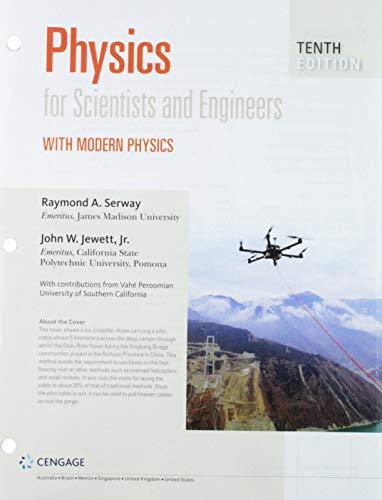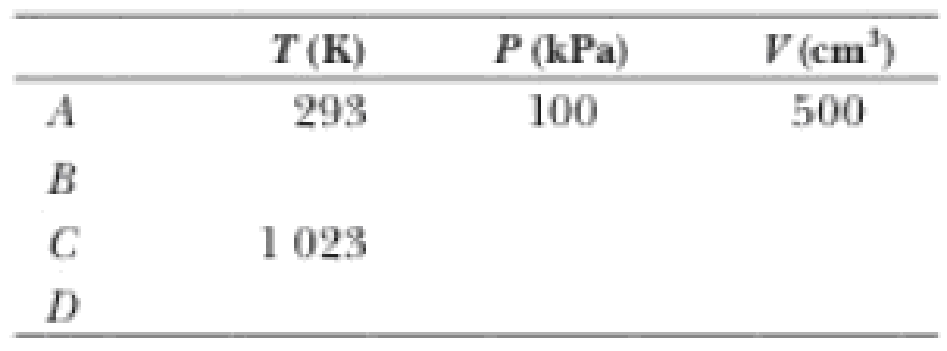
The compression ratio of an Otto cycle as shown in Figure 21.12 is VA/VB = 8.00. At the beginning A of the compression process, 500 cm3 of gas is at 100 kPa and 20.0°C. At the beginning of the adiabatic expansion, the temperature is TC = 750°C. Model the working fluid as an ideal gas with γ = 1.40. (a) Fill in this table to follow the states of the gas:

(b) Fill in this table to follow the processes:

(c) Identify the energy input |Qh|, (d) the energy exhaust |Qc|, and (e) the net output work Weng. (f) Calculate the efficiency. (g) Find the number of crankshaft revolutions per minute required for a one-cylinder engine to have an output power of 1.00 kW = 1.34 hp. Note: The
(a)
The blanks of the table to follow the states of the gas.
Answer to Problem 47CP
The complete table is shown below.
| State |
|
|
|
| A | 293 | 100 | 500 |
| B | 673 |
|
62.5 |
| C | 1023 |
|
62.5 |
| D | 445 | 152 | 500 |
Explanation of Solution
Given info: The compression ratio of an Otto cycle is
Write the expression to calculate the quantity of the gas.
Here,
Substitute
In process
Write the expression to calculate the pressure at point B.
Substitute 8 for
The compression ratio is,
Substitute
Write the expression to calculate the temperature at point B.
Substitute
At state C:
Write the expression to calculate the pressure at point C.
Substitute
State D:
Therefore, the compression ratio is,
Write the expression to calculate the pressure at point D.
Substitute
Write the expression to calculate the temperature at point D.
Substitute
From the above explanation, the complete table is given below.
| State |
|
|
|
| A | 293 | 100 | 500 |
| B | 673 |
|
62.5 |
| C | 1023 |
|
62.5 |
| D | 445 | 152 | 500 |
Conclusion:
Therefore, the complete table is given below.
| State |
|
|
|
| A | 293 | 100 | 500 |
| B | 673 |
|
62.5 |
| C | 1023 |
|
62.5 |
| D | 445 | 152 | 500 |
(b)
The blanks of the table to follow the processes.
Answer to Problem 47CP
The complete table is shown below.
| Process | Q |
|
|
|
|
0 | -162 | 162 |
|
|
149 | 0 | 149 |
|
|
0 | 246 | -246 |
|
|
-65 | 0 | -65 |
|
|
84.3 | 84.3 | 0 |
Explanation of Solution
Given info: The compression ratio of an Otto cycle is
Write the expression to calculate the energy in A to B process.
Substitute
Write the expression of first law of thermodynamics.
Substitute
Write the expression to calculate the energy in B to C process.
Substitute
Write the expression of first law of thermodynamics.
Substitute
Write the expression to calculate the energy in C to D process.
Substitute
Write the expression of first law of thermodynamics.
Substitute
The net work done is,
The net heat energy is,
Substitute
From the above explanation, the complete table is given below.
| Process | Q |
|
|
|
|
0 | -162 | 162 |
|
|
149 | 0 | 149 |
|
|
0 | 246 | -246 |
|
|
-65 | 0 | -65 |
|
|
84.3 | 84.3 | 0 |
Conclusion:
Therefore, the complete table is,
| Process | Q |
|
|
|
|
0 | -162 | 162 |
|
|
149 | 0 | 149 |
|
|
0 | 246 | -246 |
|
|
-65 | 0 | -65 |
|
|
84.3 | 84.3 | 0 |
(c)
The heat input during
Answer to Problem 47CP
The heat input during
Explanation of Solution
Given info: The compression ratio of an Otto cycle is
From part (b), the heat input during
Thus, the heat input during
Conclusion:
Therefore, the heat input during
(d)
The heat exhaust during
Answer to Problem 47CP
The heat exhaust during
Explanation of Solution
Given info: The compression ratio of an Otto cycle is
From part (b)
The heat exhaust during
Thus, the heat exhaust during
Conclusion:
Therefore, the heat exhaust during
(e)
The net work output.
Answer to Problem 47CP
The net work output is
Explanation of Solution
Given info: The compression ratio of an Otto cycle is
From part (b)
The net work output is
Thus, the net work output is
Conclusion:
Therefore, the net work output is
(f)
The thermal efficiency.
Answer to Problem 47CP
The thermal efficiency is
Explanation of Solution
Given info: The compression ratio of an Otto cycle is
Write the expression to calculate the thermal efficiency.
Substitute
Thus, the thermal efficiency is
Conclusion:
Therefore, the thermal efficiency is
(g)
The number of crankshaft revolution per minute.
Answer to Problem 47CP
The number of crankshaft revolution per minute is
Explanation of Solution
Given info: The compression ratio of an Otto cycle is
Write the expression to calculate the output power.
Here,
Substitute
Thus, the number of crankshaft revolution per minute is
Want to see more full solutions like this?
Chapter 21 Solutions
Bundle: Physics For Scientists And Engineers With Modern Physics, Loose-leaf Version, 10th + Webassign Printed Access Card For Serway/jewett's Physics For Scientists And Engineers, 10th, Single-term
Additional Science Textbook Solutions
Laboratory Manual For Human Anatomy & Physiology
Campbell Essential Biology with Physiology (5th Edition)
Introductory Chemistry (6th Edition)
Fundamentals Of Thermodynamics
Laboratory Experiments in Microbiology (12th Edition) (What's New in Microbiology)
Chemistry: An Introduction to General, Organic, and Biological Chemistry (13th Edition)
- 6. 6. There are 1000 turns on the primary side of a transformer and 200 turns on thesecondary side. If 440 V are supplied to the primary winding, what is the voltageinduced in the secondary winding? Is this a step-up or step-down transformer? 7. 80 V are supplied to the primary winding of a transformer that has 50 turns. If thesecondary side has 50,000 turns, what is the voltage induced on the secondary side?Is this a step-up or step-down transformer? 8. There are 50 turns on the primary side of a transformer and 500 turns on thesecondary side. The current through the primary winding is 6 A. What is the turnsratio of this transformer? What is the current, in milliamps, through the secondarywinding?9. The current through the primary winding on a transformer is 5 A. There are 1000turns on the primary winding and 20 turns on the secondary winding. What is theturns ratio of this transformer? What is the current, in amps, through the secondarywinding?arrow_forwardNo chatgpt plsarrow_forwardWhat is the current, in amps, across a conductor that has a resistance of10 Ω and a voltage of 20 V? 2. A conductor draws a current of 100 A and a resistance of 5 Ω. What is thevoltageacross the conductor? 3. What is the resistance, in ohm’s, of a conductor that has a voltage of 80 kVand acurrent of 200 mA? 4. An x-ray imaging system that draws a current of 90 A is supplied with 220V. What is the power consumed? 5. An x-ray is produced using 800 mA and 100 kV. What is the powerconsumed in kilowatts?arrow_forward
- ՍՈՈՒ XVirginia Western Community Coll x P Course Home X + astering.pearson.com/?courseld=13289599#/ Figure y (mm) x=0x = 0.0900 m All ✓ Correct For either the time for one full cycle is 0.040 s; this is the period. Part C - ON You are told that the two points x = 0 and x = 0.0900 m are within one wavelength of each other. If the wave is moving in the +x-direction, determine the wavelength. Express your answer to two significant figures and include the appropriate units. 0 t(s) λ = Value m 0.01 0.03 0.05 0.07 Copyright © 2025 Pearson Education Inc. All rights reserved. 日 F3 F4 F5 1775 % F6 F7 B F8 Submit Previous Answers Request Answer ? × Incorrect; Try Again; 3 attempts remaining | Terms of Use | Privacy Policy | Permissions | Contact Us | Cookie Settings 28°F Clear 4 9:23 PM 1/20/2025 F9 prt sc F10 home F11 end F12 insert delete 6 7 29 & * ( 8 9 0 t = back Οarrow_forwardPart C Find the height yi from which the rock was launched. Express your answer in meters to three significant figures. Learning Goal: To practice Problem-Solving Strategy 4.1 for projectile motion problems. A rock thrown with speed 12.0 m/s and launch angle 30.0 ∘ (above the horizontal) travels a horizontal distance of d = 19.0 m before hitting the ground. From what height was the rock thrown? Use the value g = 9.800 m/s2 for the free-fall acceleration. PROBLEM-SOLVING STRATEGY 4.1 Projectile motion problems MODEL: Is it reasonable to ignore air resistance? If so, use the projectile motion model. VISUALIZE: Establish a coordinate system with the x-axis horizontal and the y-axis vertical. Define symbols and identify what the problem is trying to find. For a launch at angle θ, the initial velocity components are vix=v0cosθ and viy=v0sinθ. SOLVE: The acceleration is known: ax=0 and ay=−g. Thus, the problem becomes one of…arrow_forwardPhys 25arrow_forward
 Physics for Scientists and EngineersPhysicsISBN:9781337553278Author:Raymond A. Serway, John W. JewettPublisher:Cengage Learning
Physics for Scientists and EngineersPhysicsISBN:9781337553278Author:Raymond A. Serway, John W. JewettPublisher:Cengage Learning Physics for Scientists and Engineers with Modern ...PhysicsISBN:9781337553292Author:Raymond A. Serway, John W. JewettPublisher:Cengage Learning
Physics for Scientists and Engineers with Modern ...PhysicsISBN:9781337553292Author:Raymond A. Serway, John W. JewettPublisher:Cengage Learning Physics for Scientists and Engineers: Foundations...PhysicsISBN:9781133939146Author:Katz, Debora M.Publisher:Cengage Learning
Physics for Scientists and Engineers: Foundations...PhysicsISBN:9781133939146Author:Katz, Debora M.Publisher:Cengage Learning Principles of Physics: A Calculus-Based TextPhysicsISBN:9781133104261Author:Raymond A. Serway, John W. JewettPublisher:Cengage Learning
Principles of Physics: A Calculus-Based TextPhysicsISBN:9781133104261Author:Raymond A. Serway, John W. JewettPublisher:Cengage Learning Physics for Scientists and Engineers, Technology ...PhysicsISBN:9781305116399Author:Raymond A. Serway, John W. JewettPublisher:Cengage Learning
Physics for Scientists and Engineers, Technology ...PhysicsISBN:9781305116399Author:Raymond A. Serway, John W. JewettPublisher:Cengage Learning





